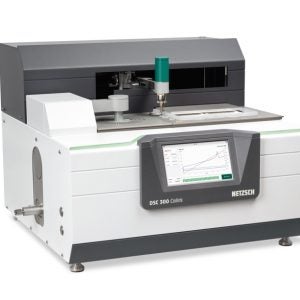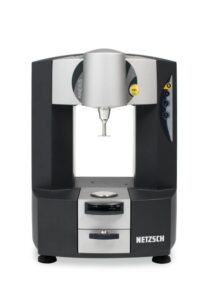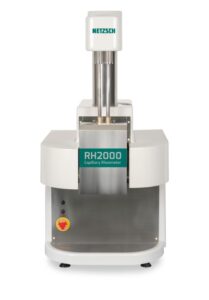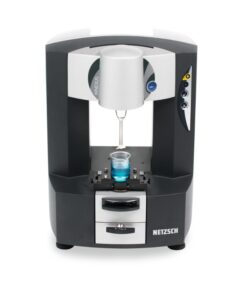Publication Day of our New Book: Thermal Analysis in the Pharmaceutical Field
Dr. Gabriele Kaiser, our Business Field Manager for Pharma, Cosmetics and Food, and Claire Strasser, Application Specialist for Pharmaceutical Applications, are the authors of our new book entitled “Thermal Analysis in the Pharmaceutical Field”.
As of today, this book is available on the NETZSCH website!
chrom+food Forum picked the brain of the authors
Dr. Kaiser and Mrs. Strasser were interviewed by the chrom+food Forum magazine and gave valuable insights into this book and the final result. Here are their answers!
What led to the realization of this book?
Dr. Gabriele Kaiser: This book, entitled “Thermal Analysis in the Pharmaceutical Field”, is a compilation of realistic application examples in the field of thermal analysis of pharmaceuticals, dealing with tasks from development and quality control.
It describes how such measurements can be performed and interpreted. The methods and definitions required for this are explained in accompanying texts. Application notes and white papers are good possibilities to obtain compact information on a specific topic. However, if you want to know more, an application note and/or a whitepaper are often not enough. That is why we have decided to present important aspects of various topics more comprehensively in the form of a book.
The work is quite extensive and comprehensive. To what extent were several authors involved in this compendium?
Dr. Gabriele Kaiser: A book of more than 200 pages can hardly be filled with content, designed and made ready for printing by just one person. A number of colleagues were involved in realizing this book. First and foremost, my co-author, Claire Strasser, who worked out most of the application examples and wrote the corresponding texts. However, there are many others who should also be mentioned, e.g., our colleagues from the applications lab, who provided us with advice, support and practical help and assisted us in proofreading. Without them, such a project would not have been possible.
What aspects and contents are the focus of the book?
Claire Strasser: The book attempts to cover as many areas as possible in which thermal analysis plays a role in the pharmaceutical field. In addition to the methodology, i.e., basic information on the equipment and software used, the eight chapters deal with the analysis of amorphous and crystalline phases, purity determination, thermal and oxidative stability, storage conditions & shelf life, polymorphism and the compatibility of substances with each other.
All these topics are explained and supported with measurement examples. The methods used are: Differential Scanning Calorimetry (DSC), Thermogravimetric Analysis (TGA), Simultaneous Thermal Analysis (STA) as well as coupling with gas analyzing systems such as FT-IR or GC-MS to TGA/STA.
All samples used in our book are solids.
Would you like to highlight some topic areas as examples?
Claire Strasser: On the one hand, I would like to highlight thermal stability. This is an important topic, because changing temperatures, e.g., during storage or transportation, can influence the properties of active pharmaceutical ingredients and excipients. This is where NETZSCH instruments are of great benefit. For example, a thermobalance measures the temperature, at which a substance begins to react or decompose.
Another exciting topic is what is known as compatibility on the other: A drug usually consists of an active ingredient and several excipients. These excipients ease the processing of the mixture, improve the appearance of the finished product, help dissolve a tablet, etc. The presence of these excipients must, of course, not necessarily influence the efficacy of the active ingredient. Initial information about a possible interaction is obtained by means of thermal analysis, namely differential scanning calorimetry (DSC) and thermogravimetric analysis (TGA).
Which of these are of particular importance?
Dr. Gabriele Kaiser: We have already mentioned thermal stability. It is particularly interesting to correlate thermal stability with the long-term behavior of a substance. For example, in the case of calcium hydrogen phosphate dehydrate ‒ a filler that is used in direct tableting ‒ we show how dehydration, which is measured by thermogravimetry, can be evaluated kinetically. For this purpose, the NETZSCH Kinetics Neo software is used. On the basis of such kinetic modeling, it is possible to make predictions under conditions that are very difficult or even impossible to measure, such as, e.g., long-term predictions over several years.
Another example I would like to mention in this context is urea. Urea exhibits a complex degradation mechanism, which fits very well with the TGA-FT-IR results we present in the book.
Valuable assistance is provided by coupling of a thermobalance and a Fourier transform infrared spectrometer, which analyzes the gas phase above the sample, identifies the gas species and thus allows conclusions to be drawn about the degradation processes.
What is the main target group of the book?
Claire Strasser: The book is aimed at both users of thermal analysis who want to learn more about applications in the pharmaceutical field and pharmacists who want to learn more about thermal ‒ regardless of whether they are beginners or experts. The concept is such that the book provides interesting aspects for each of these groups.
What is the benefit of this book?
Dr. Gabriele Kaiser: The book gives practical advice on how to perform measurements and how to interpret the results. At the same time, it provides an overview of possible applications of thermal analysis for the investigation of pharmaceuticals. Thus, it can be used in the academic field for students, in lectures or practical courses, but also in the industry for training, research or quality control.
What are your recommendations for how to read this book?
Claire Strasser: The book is designed in such a way that you can pick out individual chapters or even individual application examples. It is therefore not necessary to read the book from cover to cover in order not to miss any important information. In the exciting world of thermal analysis, it is possible to determine a multitude of important properties of active pharmaceutical ingredients and excipients with just a few milligrams of a sample. We hope that our book will take you a little closer to this world.







